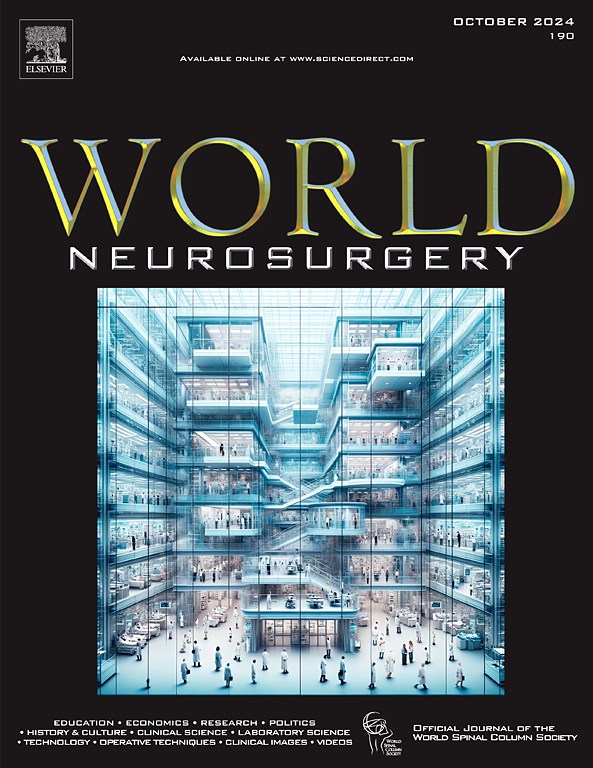遗漏硬膜下引流对慢性硬膜下血肿术后复发的影响:一项回顾性研究。
IF 2.1
4区 医学
Q3 CLINICAL NEUROLOGY
引用次数: 0
摘要
虽然硬膜下引流(SDD)放置减少了慢性硬膜下血肿(CSDH)钻孔手术后的复发,但并发症导致我们的机构停止了常规使用。在改变后的第一年,复发率为14.6%,与停药前观察到的复发率相当。因此,我们回顾性比较了150例SDD患者(SDD+组)和129例近期无SDD患者(SDD-组)。分析患者特征、复发率、并发症、手术时间、住院时间和费用。SDD+组复发率为13.9%,SDD-组复发率为8.0% (p = 0.119)。事后分析显示统计效力低(34.1%),提示II型错误的风险。SDD组的手术时间(40.9分钟vs. 54.9分钟)和住院时间(6.0天vs. 11.8天)显著缩短,每例成本降低811.8美元。并发症发生率相似(4%对1%),但SDD+组有3例严重的SDD相关并发症。多因素分析发现术前血肿厚度和术后硬膜下厚度是独立的复发因素,而SDD的使用不是。总之,不放置SDD不会显著增加复发率,但会缩短手术时间,减少住院时间和费用,减少严重并发症。虽然这项研究可能不足以明确排除复发的差异,但这些发现支持在初始手术中省略SDD的可行性。未来的随机对照试验有必要证实这些结果。本文章由计算机程序翻译,如有差异,请以英文原文为准。
Impact of Subdural Drain Omission on Recurrence After Chronic Subdural Hematoma Surgery: A Retrospective Study
Objective (Background)
Although subdural drain (SDD) placement reduces recurrence after burr-hole surgery for chronic subdural hematoma, complications have led our institution to discontinue its routine use. During the first year following this change, the recurrence rate was 14.6%, comparable to the recurrence rate observed prior to discontinuation.
Methods
We retrospectively compared 150 cases with SDD (SDD+ group) and 129 recent cases without SDD (SDD-group). Patient characteristics, recurrence rates, complications, operative time, hospital stay, and costs were analyzed.
Results
Recurrence occurred in 13.9% of the SDD+ group and 8.0% of the SDD-group (P = 0.119). Post-hoc analysis revealed low statistical power (34.1%), suggesting a risk of Type II error. The SDD-group had significantly shorter operative time (40.9 vs. 54.9 minutes) and hospital stay (6.0 vs. 11.8 days), with a cost reduction of $811.8 per case. Complication rates were similar (4% vs. 1%), but 3 serious SDD-related complications were noted in the SDD+ group. Multivariate analysis identified preoperative hematoma thickness and postoperative subdural thickness as independent recurrence factors, while SDD use was not.
Conclusions
Omitting SDD placement did not significantly increase recurrence but was associated with shorter operative times, reduced hospital stays and costs, and fewer serious complications. While the study may be underpowered to definitively rule out a difference in recurrence, these findings support the feasibility of omitting SDD in initial surgeries. Future randomized controlled trials are warranted to confirm these results.
求助全文
通过发布文献求助,成功后即可免费获取论文全文。
去求助
来源期刊

World neurosurgery
CLINICAL NEUROLOGY-SURGERY
CiteScore
3.90
自引率
15.00%
发文量
1765
审稿时长
47 days
期刊介绍:
World Neurosurgery has an open access mirror journal World Neurosurgery: X, sharing the same aims and scope, editorial team, submission system and rigorous peer review.
The journal''s mission is to:
-To provide a first-class international forum and a 2-way conduit for dialogue that is relevant to neurosurgeons and providers who care for neurosurgery patients. The categories of the exchanged information include clinical and basic science, as well as global information that provide social, political, educational, economic, cultural or societal insights and knowledge that are of significance and relevance to worldwide neurosurgery patient care.
-To act as a primary intellectual catalyst for the stimulation of creativity, the creation of new knowledge, and the enhancement of quality neurosurgical care worldwide.
-To provide a forum for communication that enriches the lives of all neurosurgeons and their colleagues; and, in so doing, enriches the lives of their patients.
Topics to be addressed in World Neurosurgery include: EDUCATION, ECONOMICS, RESEARCH, POLITICS, HISTORY, CULTURE, CLINICAL SCIENCE, LABORATORY SCIENCE, TECHNOLOGY, OPERATIVE TECHNIQUES, CLINICAL IMAGES, VIDEOS
 求助内容:
求助内容: 应助结果提醒方式:
应助结果提醒方式:


